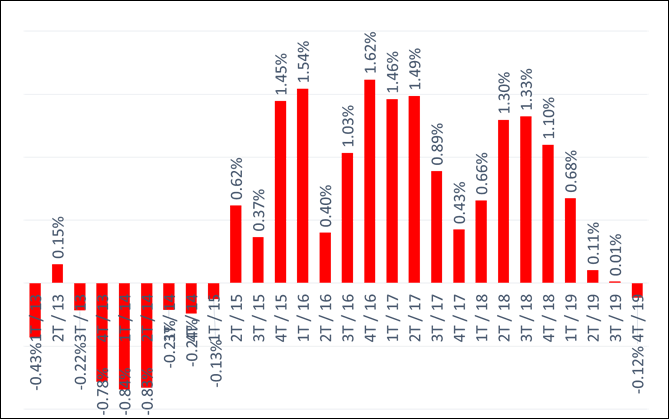In the last year, inequality of labor earnings reached its highest level in the decade. Looking at the annual series, income inequality has been rising since 2015, and in 2019 its average growth was 0.17%, the lowest rate recorded in this period, thus suggesting a stability trend. The mean per capita income kept growing for the third year in a row, reaching a growth rate of 1.6% in 2019. The combination of a rising mean income with the abovementioned stop on inequality growth led to an increase in social welfare at a rate of 1.32%, the best performance since the beginning of the economic recession in 2014.
The research disclosed by FGV Social also explores the fluctuations in the same indicators followed in each quarter of the year. The Gini Index, an indicator that measures income inequality in a range from 0 to 1 (the closest it is from 1, the highest the concentration of income), observed its first reduction in the 4th quarter of 2019, consequently ending a trajectory of 18 trimesters in a row of growing inequality of labor earnings. The Gini increased from 0.62832 in the 4th quarter of 2018 to 0.6276 in last year’s 4th quarter.
For the first time since the beginning of the economic recession, four out of the five variables that affect mean income and its distribution are positive: (i) working hours; (ii) unemployment; (iii) schooling; (iv) participation in the labor market. Both schooling and participation in the labor market (directly at the reach of the individual) were already growing during the economic crisis period. The 5th variable, hourly-wage by years of study of the worker, fell by 1.58% in 2019 in comparison with 2018. It captures the effect of productivity and informality. According to Marcelo Neri, the Director of FGV Social, “schooling and participation (the search for a job) never stopped to grow, even during the crisis. On the other hand, unemployment has started to fall, despite still at a high level, and the working hours have been increasing, which means that people are working more. The only problem is the wage variable, which continued to fall, thus negatively impacting economic growth and inequality.”
“We are at the highest level of income concentration according to PNADC microdata. Following the trend observed in the last quarter of 2019, it seems that a cyclical fall in inequality is in the horizon”, affirmed Neri. “The increase in income inequality has been losing steam, growing at a slower pace. The result obtained in the last quarter of 2019 represented the first fall in the inequality series, even if still representing a marginal decrease. The per capita labor earnings are growing, not as fast as a year ago, but the combination of both news is positive”, he assessed.
Click here to access the 2019 Social Assessment slides presentation
See also - Cuts in the Bolsa Família Programme and the Escalation of Extreme Poverty in Brazil.
Access the research "The Escalation of Inequality"
Figure 1 – Inequality of Labor Earnings (Gini) – Has it peaked?

Source: FGV Social / CPS using PNADC / IBGE microdata
OBS: Per capita Habitual Household Income – All Individuals
Figure 2 – Variation in Labor Earnings Inequality: the end of the trajectory of 18 quarters in a row of growth in the Gini (losing steam since the third quarter of 2018)

Source: FGV Social / CPS using PNADC / IBGE microdata
OBS: Per capita Habitual Household Income – All Individuals.
The mean confidence interval that we estimated by bootstrap using PNAD microdata from 1992 to 2013 was 0.596%






